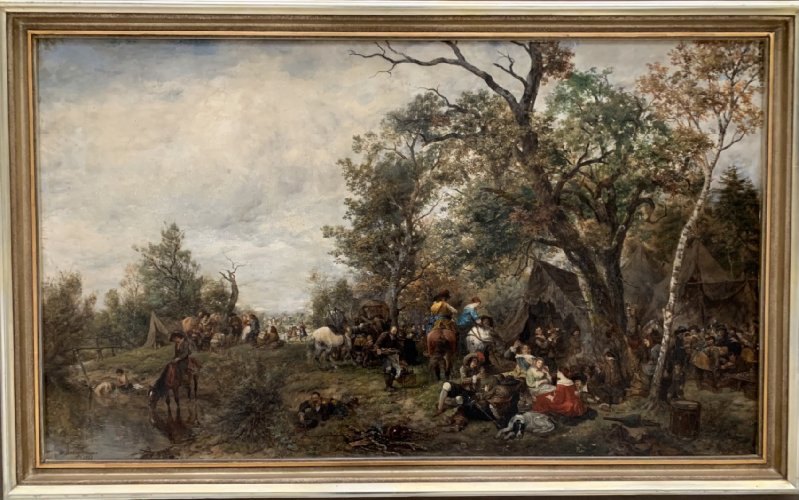Description:
Heinrich Breling (1849-1914) was a German painter and graphic artist. He began his studies in the Art Department of the Technische Hochschule in Hanover under Carl Oesterley. At the Munich Academy he was a pupil of Wilhelm von Diez. After his studies, in 1882 he was appointed professor there. Earlier he had fought in the Prussian-French War in the army of the Prussian Prince Frederick Charles. In his work he was inspired by the art of his Munich master. He painted battle scenes related to war events and representations from the Thirty Years’ War. He also undertook sentimental genre painting, mainly in historicizing costumes of the 17th century.
Description of the painting:
The painting depicts a collection of scenes taking place in a military camp located on the edge of a forest. The painting can be divided into four zones determined by the events that are taking place independently of each other. The tree trunks help to organize the space. On the right edge of the painting, against the background of an impressive tent, a group of laughing soldiers is visible, crowded around a man at a low table, on which there is a bulbous bottle of wine and silver coins. He holds one of them in his hand and looks at it carefully. Perhaps this is the moment of payment of the salary or, more likely, the winnings in the game he is playing.The painting depicts a collection of scenes taking place in a military camp located on the edge of a forest. The painting can be divided into four zones determined by the events that are taking place independently of each other. The tree trunks help to organize the space. On the right edge of the painting, against the background of an impressive tent, a group of laughing soldiers is visible, crowded around a man at a low table, on which there is a bulbous bottle of wine and silver coins. He holds one of them in his hand and looks at it carefully. Perhaps this is the moment of payment of the salary or, more likely, the winnings in the game he is playing.
In the foreground there is abandoned equipment and a drum-taraban, which is being watched by a barefoot boy, led by an older woman. Behind her, the figure of a trumpeter on a horse can be seen. The sound of the music coming from the raised trumpet emphasizes the joyful atmosphere of the scene.
The next group of figures is shown against the background of another tent and the canopy of spreading trees. On the foreground two women are visible. One of them is sitting with her back to the viewer, opposite her is another one dressed in a light dress. She establishes eye contact with the viewer, as if inviting him to the feast. The figures are significantly lighter than the rest, well lit, and portrayed in colorful costumes. In front of them lies a black and white dog, which also looks directly at the viewer. The ladies are surrounded by men portrayed in darker costumes, looking at them with longing. The group of revelers is compositionally and coloristically connected to a couple of riders on horses shown in the background to the left. The scene is completed by a tavern keeper walking from the center of the painting with a basket of provisions, bottles and a tray of fish, and a young man emerging from the depths of the tent with a dish of fruit.
The third zone depicts a lone man lying on his stomach, who is arranging coins on his hat. The soldier looks at the viewer with a cunning smile. Behind him, at the camp, soldiers are talking to the seated woman – a marketer. In the distance, the outline of the city is visible, from which two men ride on horseback.
The fourth zone depicts scenes taking place by the pond. On the foreground, a horse is walking in it, on which a young man is sitting. A little further along the shoreline, two naked children are bathing in the water. The second plan shows a dance, to which musicians have gathered.
The painting depicts a scene of rest after a won battle. The characters are resting and having fun, spending time with women or buying from the marketer’s wagon. The events are presented in great detail. Despite the many characters, each one is treated individually, with the depiction of facial features and emotions. Through the composition of the work it fits into the scheme of representing popular 18th century fête champêtre scenes, but in 17th century costumes. The composition is dynamic, the artist operates with light and shade in the work, distinguishing individual figures.


